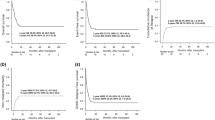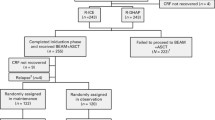Abstract
To investigate the use of high-dose therapy and autologous stem cell transplantation (ASCT) for relapsed or high-risk diffuse large B-cell lymphoma (DLBCL) between 1990 and 2007, we conducted a nationwide survey using the registry database of the Japan Society for Hematopoietic Cell Transplantation. Of the 1222 patients in the database, 576 (47%) received ASCT in first complete remission (CR1), 140 (12%) in first partial remission, 281 (23%) in sensitive relapse, 150 (12%) in resistant or sensitivity-unknown relapse, and 75 (6%) in primary refractory status. With a median follow-up of 22 months, the 2-year overall survival (OS) and progression-free survival rates were 71% and 68%, respectively. The cumulative incidences of 2-year non-relapse mortality and relapse/progression were 6% and 26%, respectively. Relapse/progression after ASCT in the rituximab era (2002–2007) was significantly lower than that in the pre-rituximab era (1990–2001; P < 0.001). Older age, male gender, poor performance status at ASCT, non-CR1 at ASCT, ASCT performed in 1990–2001, and LEED or MCEC regimen were adverse predictors of OS. Because ASCT for newly diagnosed high-risk DLBCL has not been performed recently, a registry database study to assess the impact of ASCT for relapsed or refractory DLBCL in the rituximab era is warranted.


Similar content being viewed by others
Change history
08 October 2020
This article has been retracted. Please see the Retraction Notice for more detail: https://doi.org/10.1007/s12185-020-03018-1
References
A clinical evaluation of the International Lymphoma Study Group classification of non-Hodgkin's lymphoma. The Non-Hodgkin's Lymphoma Classification Project. Blood. 1997;89:3909–18.
Chihara D, Ito H, Matsuda T, Shibata A, Katsumi A, Nakamura S, et al. Differences in incidence and trends of haematological malignancies in Japan and the United States. Br J Haematol. 2014;164:536–45.
Philip T, Guglielmi C, Hagenbeek A, Somers R, Van der Lelie H, Bron D, et al. Autologous bone marrow transplantation as compared with salvage chemotherapy in relapses of chemotherapy-sensitive non-Hodgkin's lymphoma. N Engl J Med. 1995;333:1540–5.
Kewalramani T, Zelenetz AD, Nimer SD, Portlock C, Straus D, Noy A, et al. Rituximab and ICE as second-line therapy before autologous stem cell transplantation for relapsed or primary refractory diffuse large B-cell lymphoma. Blood. 2004;103:3684–8.
Arboe B, Halgren Olsen M, Duun-Henriksen AK, Gørløv JS, Nielsen KF, Thomsen RH, et al. Prolonged hospitalization, primary refractory disease, performance status and age are prognostic factors for survival in patients with diffuse large B-cell lymphoma and transformed indolent lymphoma undergoing autologous stem cell transplantation. Leuk Lymphoma. 2018;59:1153–62.
Haioun C, Lepage E, Gisselbrecht C, Bastion Y, Coiffier B, Brice P, et al. Benefit of autologous bone marrow transplantation over sequential chemotherapy in poor-risk aggressive non-Hodgkin's lymphoma: updated results of the prospective study LNH87-2. Groupe d'Etude des Lymphomes de l'Adulte. J Clin Oncol. 1997;15:1131–7.
Linch DC, Yung L, Smith P, Maclennan K, Jack A, Hancock B, et al. Final analysis of the UKLG LY02 trial comparing 6–8 cycles of CHOP with 3 cycles of CHOP followed by a BEAM autograft in patients %3c65 years with poor prognosis histologically aggressive NHL. Br J Haematol. 2010;149:237–43.
Arranz R, Conde E, Grande C, Mateos MV, Gandarillas M, Albo C, et al. Dose-escalated CHOP and tailore intensification with IFE according to early response and followed by BEAM/autologous stem-cell transplantation in poor-risk aggressive B-cell lymphoma: a prospective study from the GEL-TAMO Study Group. Eur J Haematol. 2008;80:227–35.
Stewart DA, Bahlis N, Valentine K, Balogh A, Savoie L, Morris DG, et al. Upfront double high-dose chemotherapy with DICEP followed by BEAM and autologous stem cell transplantation for poor-prognosis aggressive non-Hodgkin lymphoma. Blood. 2006;107:4623–7.
Olivieri A, Santini G, Patti C, Chisesi T, De Souza C, Rubagotti A, et al. Upfront high-dose sequential therapy (HDS) versus VACOP-B with or without HDS in aggressive non-Hodgkin's lymphoma: long-term results by the NHLCSG. Ann Oncol. 2005;16:1941–8.
Stiff PJ, Unger JM, Cook JR, Constine LS, Couban S, Stewart DA, et al. Autologous transplantation as consolidation for aggressive non-Hodgkin's lymphoma. N Engl J Med. 2013;369:1681–90.
Kagami Y, Yamamoto K, Shibata T, Tobinai K, Imaizumi Y, Uchida T, et al. Randomized phase II study of R-CHOP-14 versus R-CHOP-14 followed by CHASER as induction therapy for high-dose chemotherapy (HDT), LEED, and autologous stem-cell transplantation (ASCT) in poor-risk diffuse large B-cell lymphoma (DLBCL): Japan Clinical Oncology Group (JCOG) Study (JCOG0908). Blood. 2017;130:4127 (abstract).
Gisselbrecht C, Glass B, Mounier N, Singh Gill D, Linch DC, Trneny M, et al. Salvage regimens with autologous transplantation for relapsed large B-cell lymphoma in the rituximab era. J Clin Oncol. 2010;28:4184–90.
Chen YB, Hochberg EP, Feng Y, Neuberg D, Rawal B, Motyckova G, et al. Characteristics and outcomes after autologous stem cell transplant for patients with relapsed or refractory diffuse large B-cell lymphoma who failed initial rituximab, cyclophosphamide, adriamycin, vincristine, and prednisone therapy compared to patients who failed cyclophosphamide, adriamycin, vincristine, and prednisone. Leuk Lymphoma. 2010;51:789–96.
Fenske TS, Hari PN, Carreras J, Zhang MJ, Kamble RT, Bolwell BJ, et al. Impact of pre-transplant rituximab on survival after autologous hematopoietic stem cell transplantation for diffuse large B cell lymphoma. Biol Blood Marrow Transplant. 2009;15:1455–64.
Mounier N, Canals C, Gisselbrecht C, Cornelissen J, Foa R, Conde E, et al. High-dose therapy and autologous stem cell transplantation in first relapse for diffuse large B cell lymphoma in the rituximab era: an analysis based on data from the European Blood and Marrow Transplantation Registry. Biol Blood Marrow Transplant. 2012;18:788–93.
Kamezaki K, Kikushige Y, Numata A, Miyamoto T, Takase K, Henzan H, et al. Rituximab does not compromise the mobilization and engraftment of autologous peripheral blood stem cells in diffuse-large B-cell lymphoma. Bone Marrow Transplant. 2007;39:523–7.
Numata A, Miyamoto T, Ohno Y, Kamimura T, Kamezaki K, Tanimoto T, et al. Long-term outcomes of autologous PBSCT for peripheral T-cell lymphoma: retrospective analysis of the experience of the Fukuoka BMT group. Bone Marrow Transplant. 2010;45:311–6.
Kameoka Y, Takahashi N, Ishizawa K, Kato Y, Ito J, Sasaki O, et al. Safety and feasibility of high-dose ranimustine (MCNU), carboplatin, etoposide, and cyclophosphamide (MCVC) therapy followed by autologous stem cell transplantation for malignant lymphoma. Int J Hematol. 2012;96:624–30.
Kameoka Y, Akagi T, Murai K, Noji H, Kato Y, Sasaki O, et al. Safety and efficacy of high-dose ranimustine (MCNU) containing regimen followed by autologous stem cell transplantation for diffuse large B-cell lymphoma. Int J Hematol. 2018;108:510–5.
Han LN, Zhou J, Hirose T, Imai Y, Ishiguro T, Chou T. Feasibility and efficacy of high-dose melphalan, cyclophosphamide, etoposide, and dexamethasone (LEED) chemotherapy with or without rituximab followed by autologous stem cell transplantation for aggressive and relapsed non-Hodgkin's lymphoma. Int J Hematol. 2006;84:174–81.
Nishiwaki S, Sugiura I, Miyata Y, Saito S, Sawa M, Nishida T, et al. Efficacy and safety of autologous peripheral blood stem cell transplantation for Philadelphia chromosome-positive acute lymphoblastic leukemia: a study protocol for a multicenter exploratory prospective study (Auto-Ph17 study). Medicine (Baltimore). 2017;96:e9568.
Ogura M, Yamamoto K, Morishima Y, Wakabayashi M, Tobinai K, Ando K, et al. R-High-CHOP/CHASER/LEED with autologous stem cell transplantation in newly diagnosed mantle cell lymphoma: JCOG0406 STUDY. Cancer Sci. 2018;109:2830–40.
Sugimoto M, Ito S, Mashima K, Umino K, Minakata D, Nakano H, et al. Retrospective evaluation of the MEAM regimen as a conditioning regimen before autologous peripheral blood stem cell transplantation for lymphoma in two centers with different dosing schedules of melphalan. Ann Hematol. 2016;95:1513–9.
Takaue Y, Watanabe T, Hoshi Y, Abe T, Matsunaga K, Saito S, et al. Effectiveness of high-dose MCNU therapy and hematopoietic stem cell autografts treatment of childhood acute leukemia/lymphoma with high-risk features. Cancer. 1991;67:1830–7.
Kato J, Mori T, Yokoyama K, Tsukada Y, Ueda T, Shimizu T, et al. Safety and efficacy of high-dose ranimustine, cytarabine, etoposide and CY (MCVAC) regimen followed by autologous peripheral blood stem cell transplantation for high-risk diffuse large B-cell lymphoma. Bone Marrow Transplant. 2011;46:923–8.
Kanda Y. Investigation of the freely available easy-to-use software 'EZR' for medical statistics. Bone Marrow Transplant. 2013;48:452–8.
Gisselbrecht C. In vivo purging and relapse prevention following ASCT. Bone Marrow Transplant. 2002;29(Suppl 1):S5–9.
Ngo L, Hee SW, Lim LC, Tao M, Quek R, Yap SP, et al. Prognostic factors in patients with diffuse large B cell lymphoma: before and after the introduction of rituximab. Leuk Lymphoma. 2008;49:462–9.
Riihijärvi S, Taskinen M, Jerkeman M, Leppä S. Male gender is an adverse prognostic factor in B-cell lymphoma patients treated with immunochemotherapy. Eur J Haematol. 2011;86:124–8.
Carella AM, de Souza CA, Luminari S, Marcheselli L, Chiappella A, di Rocco A, et al. Prognostic role of gender in diffuse large B-cell lymphoma treated with rituximab containing regimens: a Fondazione Italiana Linfomi/Grupo de Estudos em Moléstias Onco-Hematológicas retrospective study. Leuk Lymphoma. 2013;54:53–7.
Müller C, Murawski N, Wiesen MH, Held G, Poeschel V, Zeynalova S, et al. The role of sex and weight on rituximab clearance and serum elimination half-life in elderly patients with DLBCL. Blood. 2012;119:3276–84.
Pfreundschuh M, Müller C, Zeynalova S, Kuhnt E, Wiesen MH, Held G, et al. Suboptimal dosing of rituximab in male and female patients with DLBCL. Blood. 2014;123:640–6.
Junlén HR, Peterson S, Kimby E, Lockmer S, Lindén O, Nilsson-Ehle H, et al. Follicular lymphoma in Sweden: nationwide improved survival in the rituximab era, particularly in elderly women: a Swedish Lymphoma Registry study. Leukemia. 2015;29:668–76.
Chihara D, Izutsu K, Kondo E, Sakai R, Mizuta S, Yokoyama K, et al. High-dose chemotherapy with autologous stem cell transplantation for elderly patients with relapsed/refractory diffuse large B cell lymphoma: a nationwide retrospective study. Biol Blood Marrow Transplant. 2014;20:684–9.
Lane AA, Armand P, Feng Y, Neuberg DS, Abramson JS, Brown JR, et al. Risk factors for development of pneumonitis after high-dose chemotherapy with cyclophosphamide, BCNU and etoposide followed by autologous stem cell transplant. Leuk Lymphoma. 2012;53:1130–6.
Caimi PF, William BM, Silva Rondon CH, Fu P, Cooper BW, Campagnaro EL, et al. Comparison of 2 carmustine-containing regimens in the rituximab era: excellent outcomes even in poor-risk patients. Biol Blood Marrow Transplant. 2015;21:1926–31.
Alessandrino EP, Bernasconi P, Colombo A, Caldera D, Martinelli G, Vitulo P, et al. Pulmonary toxicity following carmustine-based preparative regimens and autologous peripheral blood progenitor cell transplantation in hematological malignancies. Bone Marrow Transplant. 2000;25:309–13.
Haioun C, Lepage E, Gisselbrecht C, Salles G, Coiffier B, Brice P, et al. Survival benefit of high-dose therapy in poor-risk aggressive non-Hodgkin's lymphoma: final analysis of the prospective LNH87-2 protocol—a groupe d'Etude des lymphomes de l'Adulte study. J Clin Oncol. 2000;18:3025–30.
Acknowledgements
We thank all the staff of the Japanese Data Center for Hematopoietic Cell Transplantation and transplant centers in Japan for their excellent assistance and cooperation.
Funding
This work was supported by grants from the National Cancer Research and Development Fund (29-A-14, T.F.).
Author information
Authors and Affiliations
Corresponding author
Ethics declarations
Conflict of interest
There are no other conflicts of interest to report.
Additional information
Publisher's Note
Springer Nature remains neutral with regard to jurisdictional claims in published maps and institutional affiliations.
Electronic supplementary material
Below is the link to the electronic supplementary material.
About this article
Cite this article
Kim, SW., Asakura, Y., Tajima, K. et al. RETRACTED ARTICLE: High-dose therapy and autologous stem cell transplantation for relapsed or high-risk diffuse large B-cell lymphoma: a nationwide survey. Int J Hematol 111, 256–266 (2020). https://doi.org/10.1007/s12185-019-02772-1
Received:
Revised:
Accepted:
Published:
Issue Date:
DOI: https://doi.org/10.1007/s12185-019-02772-1




